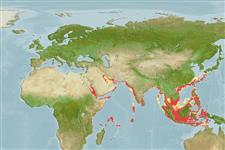Teleostei (teleosts) >
Eupercaria/misc (Various families in series Eupercaria) >
Nemipteridae (Threadfin breams, Whiptail breams)
Etymology: Nemipterus: Greek, nema, -atos = filament + Greek, pteron = wing, fin (Ref. 45335).
More on author: Bloch.
Environment: milieu / climate zone / depth range / distribution range
Ecology
Marine; demersal; non-migratory; depth range 5 - 80 m (Ref. 9785). Tropical; 34°N - 11°S, 31°E - 133°E (Ref. 3810)
Indo-Pacific.
Length at first maturity / Size / Weight / Age
Maturity: Lm 18.3 range ? - ? cm
Max length : 34.0 cm TL male/unsexed; (Ref. 124816); common length : 25.0 cm TL male/unsexed; (Ref. 5450); max. published weight: 596.00 g (Ref. 1448); max. reported age: 8 years (Ref. 1448)
Dorsal spines (total): 10; Dorsal soft rays (total): 9; Anal spines: 3; Anal soft rays: 7. This species is distinguished by the following characters: lower margin of eye above a line from tip of snout to upper base of pectoral fins; a line drawn up from the posterior edge of suborbital reaching the dorsal profile 2 to 4 scale rows before origin of dorsal fin; pectoral fins very long, 1-1.3 in HL, reaching to or just beyond level of origin of anal fin; pelvic fins moderately long, 1.2-1.6 in HL, reaching to or just beyond anus; caudal fin moderately forked, upper lobe slightly longer than lower and produced into a short or moderately long filament. Colour: upper part of body pinkish, becoming silvery below; top of head behind eye with a golden sheen; 11-12 pale golden-yellow stripes along body from behind head to base of caudal fin; a prominent red-suffused yellow blotch below origin of lateral line; dorsal fin whitish, margin of fin yellow, edged with red; a pale lemon stripe near base of dorsal fin, this stripe narrow anteriorly and widening on posterior part of fin; anal fin whitish with pale lemon broken lines or scribblings over most of fin; caudal fin pink, upper tip and filament yellow (Ref. 9785).
Very abundant in coastal waters, found on mud or sand bottoms, usually in schools. Feeds mainly on small fishes, crustaceans, mollusks (mainly cephalopods), polychaetes and echinoderms. Marketed mainly fresh, but also frozen, steamed, dried-salted, dry-smoked, fermented or made into fish balls and fish meal.
Females predominate at small sizes and males at larger sizes, due to faster growth rate in males (Ref. 6254).
Russell, B.C., 1990. FAO Species Catalogue. Vol. 12. Nemipterid fishes of the world. (Threadfin breams, whiptail breams, monocle breams, dwarf monocle breams, and coral breams). Family Nemipteridae. An annotated and illustrated catalogue of nemipterid species known to date. FAO Fish. Synop. 125(12):149p. Rome: FAO. (Ref. 3810)
IUCN Red List Status (Ref. 130435: Version 2024-2)
Threat to humans
Harmless
Human uses
Fisheries: commercial
Tools
Special reports
Download XML
Internet sources
Estimates based on models
Preferred temperature (Ref.
123201): 24.7 - 29.2, mean 28.4 °C (based on 1310 cells).
Phylogenetic diversity index (Ref.
82804): PD
50 = 0.5000 [Uniqueness, from 0.5 = low to 2.0 = high].
Bayesian length-weight: a=0.01413 (0.01230 - 0.01622), b=2.95 (2.92 - 2.98), in cm total length, based on LWR estimates for this species (Ref.
93245).
Trophic level (Ref.
69278): 4.2 ±0.81 se; based on food items.
Generation time: 1.9 (1.7 - 2.1) years. Estimated as median ln(3)/K based on 65
growth studies.
Resilience (Ref.
120179): Medium, minimum population doubling time 1.4 - 4.4 years (K=0.29-1.06; tm= 0.5-1.4; tmax=8; Fec = 13,900).
Prior r = 0.58, 95% CL = 0.38 - 0.86, Based on 1 full stock assessment.
Fishing Vulnerability (Ref.
59153): Low vulnerability (21 of 100).
Climate Vulnerability (Ref.
125649): High vulnerability (57 of 100).
Nutrients (Ref.
124155): Calcium = 452 [102, 857] mg/100g; Iron = 1.47 [0.45, 3.98] mg/100g; Protein = 18 [16, 20] %; Omega3 = 0.276 [0.133, 0.605] g/100g; Selenium = 40.4 [15.7, 122.5] μg/100g; VitaminA = 13.5 [3.1, 72.7] μg/100g; Zinc = 0.679 [0.387, 2.339] mg/100g (wet weight); based on
nutrient studies.
